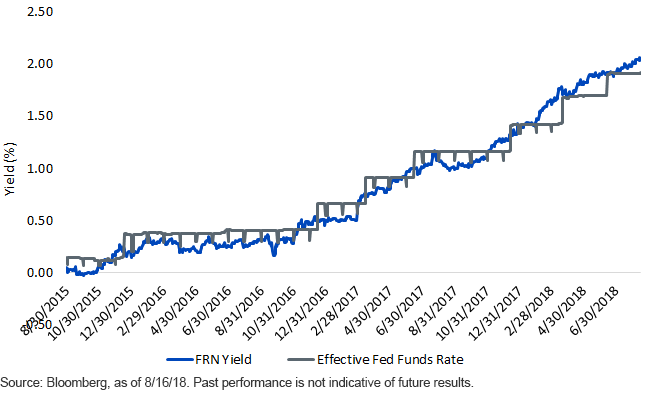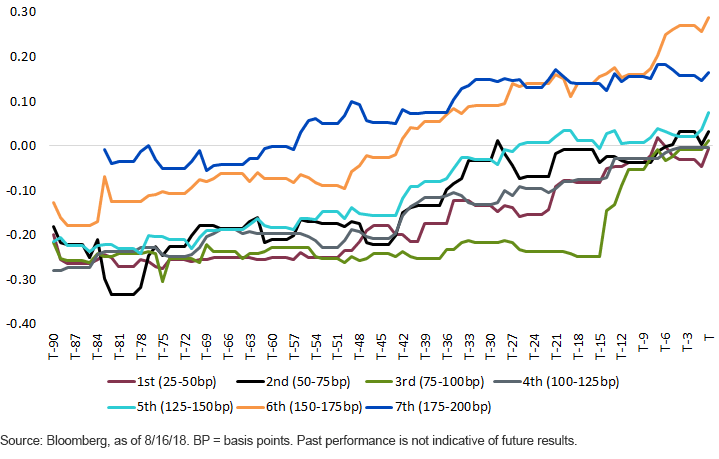Fed Protection: Digging Deeper into Our Rising Rates Thesis


In the first quarter of 2018, we highlighted the rationale for our highest-conviction fixed income trade over the next two years. Despite making headlines, Jamie Dimon’s concern about a 5% 10-Year Treasury yield is probably only a 10% probability, in our view.
However, our fixed income team has much higher conviction regarding the path of short-term rates over the next two years. As a result, investors should favor floating rate instruments versus fixed rate bonds. After discussing this research with investors, we frequently fielded questions about why U.S. Treasury floating rate notes (FRNs) would track the Federal Funds Rate higher and how long it would take for changes in Federal Reserve (Fed) policy to be reflected in FRN yields.
Question #1: FRNs vs. the Fed Funds Rate
Despite having a two-year maturity, the yield of an FRN can be decomposed into its principal parts: three-month t-bill yields + spread determined at the time the FRN is auctioned. Therefore, as three-month bill yields increase, the income component on the FRN increases. Next, without going into too much detail, the Fed is able to control the effective Federal Funds Rate though a combination of open market operations (i.e., buying, selling, borrowing and lending a narrow subset of securities) and also using the interest rate on excess reserves to influence the cost and supply of dollars. Therefore, the price that the U.S. Treasury pays to borrow at the short end of the yield curve is directly impacted by Fed policy. As we show below, the relationship between the effective Fed Funds Rate and FRN yields move in virtual lockstep. For this reason, we feel comfortable thinking about FRN yields as a call on Fed rate hikes.
FRN Yield vs. Effective Fed Funds Rate

Question #2: How long does it take for changes in Fed policy to be reflected in FRN yields?
While this question is similar to the first, the drivers are slightly different. While the Fed Funds Rate target band increases in a knee-jerk fashion as the Fed hikes rates, FRN yields tend to evolve in a smoother path over time. This is primarily a function of the anticipatory nature of markets. Taking it a step further, the evolution of the yield offered by FRNs will be impacted by the amount of time between potential changes in Fed policy and the degree of certainty that those rate hikes will occur.
In the chart below, we show the evolution of FRN yields leading up to a change in Fed policy. The zero line on the vertical axis means that the FRN yield is equal to the top band of the effective Fed Funds Rate. Generally speaking, FRN yields have been in line with the top band by about two weeks in advance. Put another way, FRN yields have historically started to track the effective Fed Funds Rate between 60 and 80 days prior to a change in Fed policy. Again, the evolution of yields is a combination of how many days an FRN will accrue at various short-term rates combined with the likelihood of a change in policy at a future date. Note that during the Fed’s third rate hike, consensus shifted quickly resulting in a fairly steep increase in the two weeks leading up to the Fed meeting.
Day to Rate Hike: FRN Yield - Fed Funds Rate (Upped Bound)

Conclusion
As markets continue to grapple with uncertainty, we continue to debate where we have the highest levels of conviction to generate positive total returns. FRNs currently combine attractive levels of income with among the lowest levels of volatility of any asset class. Based on our view that the Fed will hike two more times in 2018, we continue to see value in the WisdomTree Floating Rate Treasury Fund (USFR), leading the way to access the asset class or short-duration fixed income.
Important Risks Related to this Article
There are risks associated with investing, including possible loss of principal. Securities with floating rates can be less sensitive to interest rate changes than securities with fixed interest rates but may decline in value. The issuance of floating rate notes by the U.S. Treasury is new and the amount of supply will be limited. Fixed income securities will normally decline in value as interest rates rise. The value of an investment in the Fund may change quickly and without warning in response to issuer or counterparty defaults and changes in the credit ratings of the Fund’s portfolio investments. Due to the investment strategy of this Fund, it may make higher capital gain distributions than other ETFs. Please read the Fund’s prospectus for specific details regarding the Fund’s risk profile.


